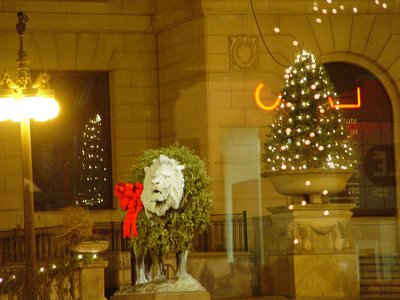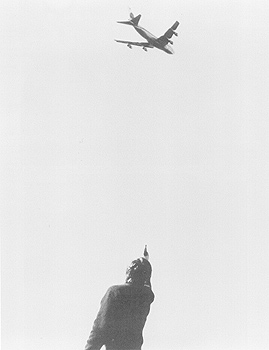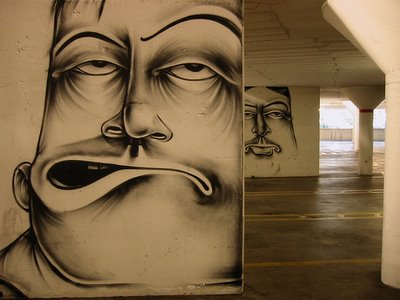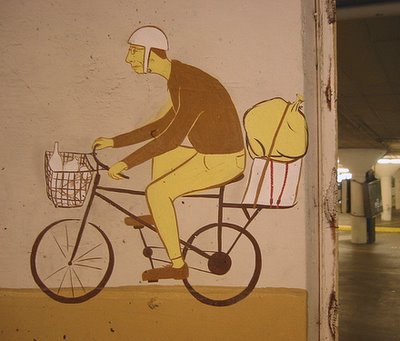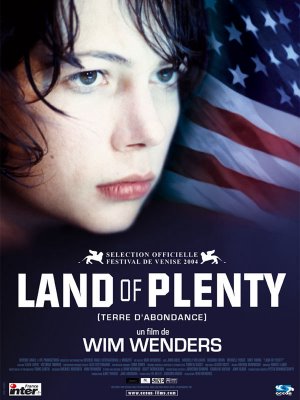by Gregg Chadwick
On February 8, 2006 in Los Angeles at the Grammy Awards, Bruce Springsteen roused the audience with his solo acoustic performance of the title track to his 2005 album, "Devils & Dust." Springsteen's haunting rendition was the most intense performance of the evening and offered the only political commentary during the show. Springsteen added a coda to his song, about a soldier in Iraq, by declaring, "Bring 'em home."
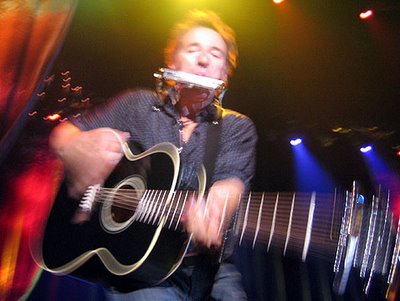
"Springsteen makes me keep faith in America."
-Billy Bragg
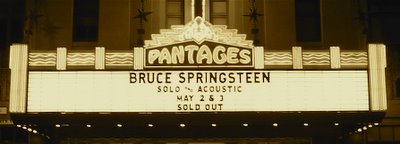
Bruce Springsteen is a man who takes risks with his music and his politics. On May 3, 2005 in Hollywood at the Pantages Theater it seemed that Springsteen let everything ride musically in a last chance to save America's soul. In two numbers culled from his Reagan era album "Nebraska" - "Reason to Believe" and "Johnny 99" - like numerous blues artists and Bob Dylan before him - Springsteen howled the lyrics through a bullet shaped harmonica microphone, amplifying his voice into a guttural roar, “Lord won't you tell us what does it mean/ At the end of every hard-earned day you can find some reason to believe." These two songs were re-imagined as twenty first century blues for America.
 |
| photo by Gregg Chadwick |
Springsteen grew up in New Jersey, in the shadows of both Manhattan and the Statue of Liberty. In this new tour supporting his album "Devils and Dust", the words inscribed at the base of the statue, "give me your tired and hungry and poor" are seen as an American responsibility as deep as the themes of parenthood that run through his new songs.
In Springsteen's world, we bear responsibility for the living because there is nothing more precious nor more fragile than life itself. In Springsteen's world, an imaginary line that runs on maps between countries does not alleviate one from caring for the humanity of those, who by chance alone, were born on the other side. "America needs to do something soon about its immigration policies" Bruce lamented before sliding into "The Line".
 |
| photo by Gregg Chadwick |
My companion at the concert was a University professor who studies the strength factors in immigrant women from Mexico and was visibly moved by the nuances in Springsteen's songs/stories/poems. Bruce's attention to the moment allows his music to weave tales with a minimum of detail. The music critic Greil Marcus explains:
"It's amazing how much Springsteen can do in just a few lines ... you know exactly where you are and you can follow the story."
And Springsteen is not afraid to create music with deep spiritual roots. “I was brought up Catholic -"Jesus is my home boy", Springsteen exclaimed to the audience at the Pantages - then gently moved into "Jesus Was an Only Son".
The great religious historian, Huston Smith said something similar to me when he professed his deep admiration for the wisdom traditions of the East yet described his spiritual practice as rooted in his childhood upbringing as the son of a Protestant missionary family in pre WWII China. Springsteen seems to echo Huston Smith's thought that spirituality can quickly become mush if time has not been given to one's own history. Only by knowing who we are and where we come from can we understand that the beauty of religion, and life, is found in inclusion not exclusion.
Springsteen's full band concerts are almost like spiritual revival meetings - ecstatic, emotional and group oriented.
Bruce's recent series of solo-concerts are more introspective. By going out there alone with just a guitar and his deep, rich and at times ragged voice, Springsteen seems to be imploring each one of us to take back our country. The responsibility is ours.
"Fear is a dangerous thing... It will take a God filled soul and fill it with devils and dust”; Springsteen sings each night on this tour. It is this fear more than any outside threat that we really need to combat before we are left with an empty, soulless country filled with devils and dust.
*
Springsteen Live
"It took me a long, long time to decide that I was going to be a songwriter myself, but 'Thunder Road' started the process."
Damon Gough, "Badly Drawn Boy"

Released this week is the newly remastered audio disc from Springsteen and the E-Street Band's 1975 dates at the Hammersmith Odeon in London. (Available on iTunes, Napster, Rhapsody , and Connect).
What's next for Springsteen?
Bruce should soon record and release a Norteno influenced remix of his recent work including the song "Matamoros Banks" but sung in Spanish.
More on Springsteen:
*
Nic Hornby, author of "Hi-Fidelity" and "About a Boy" on Bruce
*
Hopper and Springsteen

Edward Hopper
"Nighthawks" (detail)
Art Institute of Chicago














